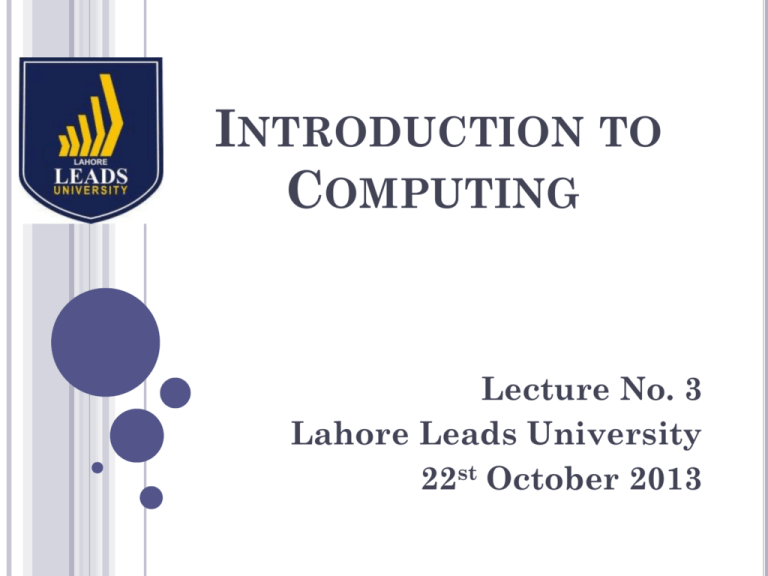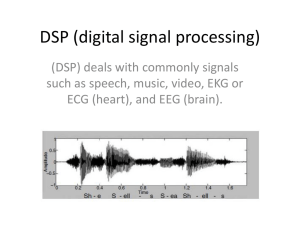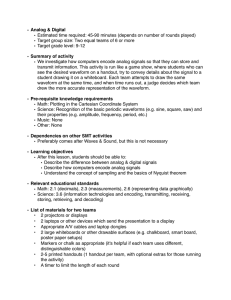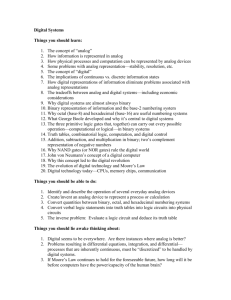Introduction to Programming
advertisement

INTRODUCTION TO COMPUTING Lecture No. 3 Lahore Leads University 22st October 2013 SHOULD SOFTWARE ENGINEERS AND CS&IT PEOPLE WORRY ABOUT HARDWARE Will start the lecture from the Point that we have discussed in the Last Lecture, that was “some students of computer and information sciences look computer hardware the same way as Drivers look at their cars” Yes it is a fact that to drive the use of a car doesn’t require a driver to build one. Same is the case with you all, it might not be vital to know the design and build a computer but if you know the design it will go a long way to improve your skills. It will also help in your professional life. How? (On next slide) HOW? It might be a case that someone of you will go into a career that involve Computer programming, Computer system design, if that is the case the principle of computer organization will provide you tools to create better design. This will include: 1. System Design Tools: The same design theories used at the lowest level of system design are applied to the higher levels. As an Example the same method used by a circuit board designer to interface between a processor and memory chips are used to design the addressing scheme of an IP Network TOOLS TO CREATE BETTER DESIGN 2. Software Design Tools The Same procedure used to optimize the digital circuits can be used for the logical portion of the software. As an example complex blocks of if-else statement can be used to simplify the design in order to achieve a much quicker output. 3. Improved trouble shooting skills If you completely understand the computer you will have an edge to trouble shoot much quicker than others. Think about it yourself and you all will agree to that. TOOLS TO CREATE BETTER DESIGN (CONTINUED) 4. Interconnectivity Hardware is needed to connect the real world to the computers input and output. You have to interface the device via ports. If you understand the interfaces and the programming mechanism you can easily introduce interconnectivity. 5. Marketability Embedded system design puts microprocessor into tasks specific applications. Processors are becoming cheap on daily to daily basis. AN EXAMPLE OF EMBEDDED SYSTEM PROCESSOR DEVICE GPS stands for Global Positioning System. It is used to determine your geographical location. In Europe one can use a device known as GPS Device to find routes, locations. It is a task specific device. You can also find information on your computers just by accessing “GOOGLE maps”. The only issue will be that it will not be a real time tracking if you want it to be a real time tracker than you have to plug a device. The purpose of this information is to let you know that it is all about software development that has made life easier for us. AN EXAMPLE OF A DIGITAL SYSTEM NON- DIGITAL SIGNALS The real world is Analog. What does that mean now? The answer to that is “An analog value is equal to a floating point no. having infinite number of values at the right of a decimal point” Example is temperature, they don’t take distinct values. Yes on your thermometer you observe degree values like 99, 100 etc. but in real world they take values like 99.987645. Another example is weight a Human Being doesn’t exactly weigh 178 Pounds. A REAL ANALOG SIGNAL If the value is changing at every second than the values are represented by a continuous signal that is given below; DIGITAL SIGNALS There were computers called Analog Computers that existed before. They used to process information on the basis of levels of electricity or the positions of mechanical devices. Modern computing don’t do this. Modern computing is digital, they convert it to a number with a fix resolution means that the digits to the right are fixed decimal points instead of infinite value. DIGITAL SIGNALS CONTINUED The values are taken with respect to the time. A table is given below that is representing the Digital Values. DIGITAL SIGNALS CONTINUED Since the computer look at the world with a fixed resolution in both time and magnitude, when a computer records an analog signal such as sound waves from music, it does it by taking a sequence of snap shots. You will find a signal on the next slide demonstrating the sound wave. The computer only measure at intervals. Each measurement is called a sample. The rate at which these samples are taken is called a sampling rate EXAMPLE OF SAMPLING PROBLEMS WHILE SAMPLING A CONVERSION SYSTEM REPRESENTATION OF A DIGITAL SIGNAL TYPES OF DIGITAL SIGNALS We have already studied this in the last lecture. Two types are Edges and Pulses. SIGNAL WAVEFORM COMPARISON OF TWO PULSES SOME UNIT PREFIXES PROBLEMS TO BE SOLVED Define the term sample as it applies to the digital system? Define the term sampling rate? What are the two primary problems that sampling can cause? Name the three parts of the system used to input an analog signal into a digital system and describe their purpose? Name four benefits of a digital system over analog system If a computer runs at 12.8 GHz, what is the period of its clock signal?











